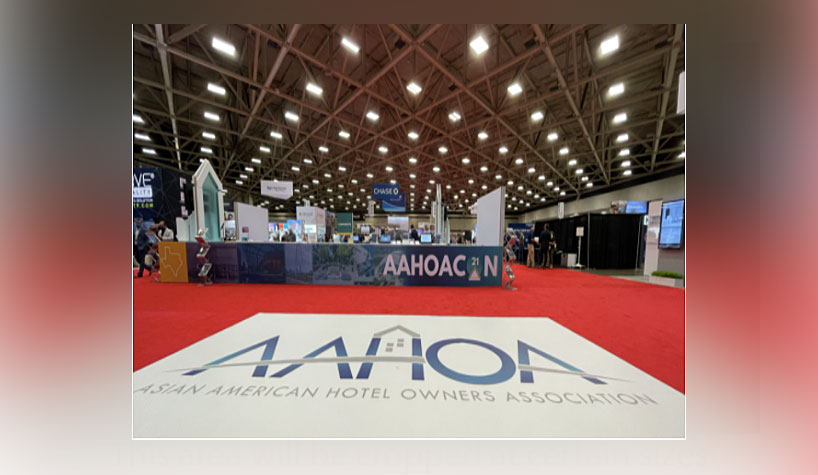DALLAS—Leaders from the hotel franchise and technology communities met on the eve of the AAHOACON21 conference to discuss the state of their markets, keys to a sustained recovery and the role of innovation in pushing forward the franchise business model.
Among the participants:
Vinay Patel, CEO, Fairbrook Hotels and incoming AAHOA chair
Anant Patel, CEO, Centerpoint Hospitality
Nancy Patel, VP, Kosmada LLC
Adam Suleman, EVP, Equinox Hospitality
Rajiv Trivedi, managing principal, TST Capital
Chinmai Sharma, president, RateGain Americas
Sanjay Nagalia, COO, IDeaS
Mike Chuma, VP global marketing, enablement and engagement, IDeaS
Michael Frenkel, president, MFC PR/Travel Conversations LLC (moderator)
Cost pressures, uncertainty and market segmentation
The conversation began on familiar ground, as the group discussed pricing pressures related to increasing costs of materials, wages and a constrained ability to fully staff hotels as a result of revenue challenges.
Vinay Patel noted that “the common theme is the unknown,” with some hotels, especially those driven by revenues from leisure travel, beating 2019 numbers, while others remain off by 20% or 30% or more.
He noted significant performance divergences among geographical markets as well as property type, as he canvassed the franchise community in preparation for his top role at AAHOA.
Trivedi noted that there is no consistent trend across the country, with geographical as well as local political factors weighing heavily on outlook, travel patterns and the pace of recovery.
He pointed to the restart of schools and the sports season in the fall as potentially positive factors driving demand, while the persistent challenges of mortgage and labor costs remain constant.
“For hotel owners, the focus has always been on the bottom line and will continue to be so,” he said.
The promise of automation
One path for reclaiming profitability runs through technology, with the group agreeing that automated solutions have evolved from a “nice to have” to a “must have” for many franchise owners.
Kosmada’s Nancy Patel noted that solutions ranging from virtual meeting software to data mining to revenue management all have a role to play.
The group debated the ongoing relevance of the OTAs, with about half the participants arguing they are more central and challenging than ever—while others admitted that OTAs can be embraced as partners to build business and meet revenue shortfalls.
Nagalia of IDeaS observed that with a complete upheaval in historical data, the rules of the road may have changed, including with OTAs. He noted that some hotels have found ways to use changing commission structures to their advantage, which can sometimes mean reducing commissions, at the other times “just giving them the right amount.”
Back on property, the group noted the accelerated importance of appropriate revenue management techniques for forecasting demand and optimizing profits.
Two franchise owners agreed that “owners are nervous” about implementing new solutions, especially given the demands on their time and costs. Innovations that can function as “set it and forget it” solutions are primed to be successful, specifically solutions that can be run easily through a mobile device and that require little time commitment from franchisees.
Also important is connecting revenue solutions to the broader commercial technology infrastructure of a hotel, including property management, pricing and marketing automation solutions.
Trivedi noted the potential of marketing automation for the future, and reinforced the value of “lightweight” technologies in the revenue and data management space as well.
RateGain’s Sharma agreed that there is there is no way back, as chains move quickly toward adopting full commercial platforms.
The more comprehensive and easy to use the platform is, the greater the likelihood of its adoption by franchisees, and franchise-driven brands.
Despite pace and uncertainty, never a more interesting time to be a hotelier
Suleman of Equinox Hotels noted that “there is a lot of pivoting for the future” as hotels consider their PIPs and the potential for new deals. Buyers and sellers often remain some distance apart—and “I’ve never seen a more interesting time” to be considering options, in a dealmaking career that dates back to Starwood and the robust market of the 2010s.
Centerpoint’s Anant Patel agreed, noting that now more than ever, the ultimate driver of property value and potential is matching the level of guest expectations with a franchisee’s ability to deliver.
Successfully matching expectation sets is one reason the economy extended stay segment outperformed during the pandemic period, and is likely to continue to do so.
Trivedi agreed, adding that the price/value equation is now critical more than ever. Here and in other areas, innovation seems key. The innovation needed must begin even before check-in, extend through arrival and entering one’s room and continue with the management of revenue and operations throughout the guest stay.
Now more than ever, it seems that lightweight, automated solutions hold the key to future franchisee profitability.
